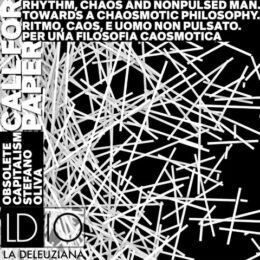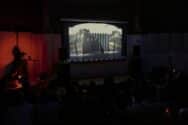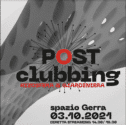Open Call for papers – La Deleuziana n. 10 (Nov-Dec. 2019)
Rhythm, chaos and nonpulsed man. Towards a chaosmotic philosophy.
«Zarathustra is only speeds and slownesses, and the eternal return, the life of the eternal return, is the first great concrete freeing of nonpulsed time.» Gilles Deleuze and Felix Guattari, 1987, A Thousand Plateaus. Capitalism and schizophrenia. by Brian Massumi (trans. and ed.), Minneapolis, MN: University of Minnesota Press, p. 269.
«Nature appears as a rhythmic character with infinite transformations»
Deleuze and Guattari, 1987, A Thousand Plateaus, p. 319.
«Relation identity […] is produced in the chaotic network of Relation and not in the hidden violence affiliation; […] does not think of a land as a territory from which to project toward other territories but as a place where one gives-on-and-with rather than grasps.» Édouard Glissant, 1997, Poetics of Relations, by Betsy Wing (trans.), Ann Arbor: University of Michigan Press, p. 144.
The topic of rhythm, as well as of sound and music, has always appeared on the Deleuze-Plateau. Apparently, Deleuze started to focus persistently on the rhythmic and musical discourse in his scripts only from the second half of the 1970s, and only after his collaborations with Guattari. However, it is equally true that hidden in the folds of Deleuzian philosophy of difference, the topic of the repetition-measure – repetition as symmetry, oriented and codified – and repetition-rhythm – repetition as power, productive and differentiating – appears already in the first pages of Difference and Repetition, first published in 1968. Additionally, in 1964, in his book on Proust, Proust and Signs, Deleuze had already recognized that Proustian essence was nothing but the «absolute and ultimate Difference», while only Vinteuil’s septet could claim that the world of differences can exist on the Earth. Where did this array of differences live? In the world of art, Proust wrote: «Thanks to art, instead of seeing a single world, our own, we see it multiply, and as many original artists as there are, so many worlds will we have at our disposal, more different from each other than those that circle in the void…».
Hence, Deleuze, in the 1970s, already analyzed music and rhythm thanks to Nietzsche and Proust, who had put music and rhythm-repetition at the core of their sensibility and their writings. In particular, Nietzsche, according to Deleuze, is the philosopher that, due to his profound denial of the measure of his own time and of the European civilization he lived in, identifies with a painful intuition the liberating Rhythm of our essence. Nietzsche advances this concept through the mask of his most famous “rhythmic character”, that is, Zarathustra. Nietzsche makes him announce the most powerful charade of all human spiritual doctrines ever conceived by a human mind, the Eternal Return, which Deleuze rightly interpreted as «the first great concrete freeing of nonpulsed time»: random, unforeseeable time of difference. Or, using a word borrowed from contemporary music, ‘alea’. These rhythmic topics in the 1960s remained stratified as underground walls of inverse fault lines, but they never developed as key structure of Deleuzian thought.
In the second half of the 1970s, he published Kafka written with Guattari (1975) and Dialogues with Parnet (1977), and, above all, the proceedings of the conference Rendre audible des forces non audible at the IRCAM in Paris (1978). In these writings, the articulated dimension of pulsed and nonpulsed time, of rhythm and individuation, speed and slowness, and autonomy of sound which becomes landscape production, forge some authentically Deleuzian concepts such as melodic landscape, audible colour, and rhythmic character. Singular territorial individuations for a nonpulsed time-space. These concepts will find an extraordinary and unusual allocation in A Thousand Plateaus (1980), the second volume of Capitalism and Schizophrenia, a true “musical” book, full of geo-philosophical variations on the topic of Rhythm. The conceptual core of this new way of conceiving Nature as a «rhythmic character with infinite transformations» is located in the ninth plateau, 1837: Of The Refrain, concept to which Deleuze and Guattari attribute crucial importance.
The relationship between music and philosophy in Deleuze’s thought can thus be considered in terms of fruitful hybridization, which leads in some emblematic cases to a flow of categories from one domain to another. A first emblematic case can be represented by the great attention that Deleuze and Guattari directed to the classical and romantic Western music tradition, as well as to more recent musical output by neo-vanguards, repeatedly mentioned in the pages of A Thousand Plateaus. A second case that cannot be ignored is the musical potential of concepts such as difference and repetition, rhizome, territorialization and deterritorialization (and again re-territorialization), which stimulated the musicological reflection and fueled the composing practices of many musicians, who explicitly recognized the influence of the Deleuzian conceptual apparatus (see Dusapin, Aperghis or Bernhard Lang). The third case is more complicated. It is the journey made by concepts born within the context of musical theory that are revisited by Deleuze and Guattari from a philosophical point of view. For example, the refrain, or the duo of smooth/striated space, derived from Pierre Boulez considerations on the relationship between the continuum of audible frequencies and the segmentation of discrete intervals. Finally, even more complicated is the parabola of influences that range from music to philosophy and back to music again, which is well expressed in the relationship of mutual influence between Deleuze and Pascale Criton, composer and theorist.
The four itineraries mentioned here (Deleuzian reinterpretation of European musical tradition; the application of philosophical concepts to the theory and practice of music; the application of concepts originated in the music sphere to the philosophical analysis; mutual influence between music and philosophy) do not try to exhaust the numerous possibilities of development of Deleuze’s “pensée-musique”, but rather to hint at the rhizomatic and unforeseeable nature of the relationships that exist between art and philosophy, which, together with science, are regarded in What is Philosophy? (1991) as diverse (though sympathetic and, in a way, similar) creative practices.
Hence, the 10th issue of La Deleuziana plans to explore Deleuze and Guattari’s philosophy as philosophy of Rhythm and Chaos, that is, Chaosmos. It aims at understanding whether it is possible to derive from such perspective more and different itineraries of liberation and creation. Finally, it intends to understand whether it is feasible to consider thought itself as sound, or Rhythm, overturning the “ancient belief” which, from Ancient Greece up to the present hypermetric society, has legitimated the “geometrical splendor” of enarhythmic men and of measure-repetition, which has produced in our society both extraordinary developments and extraordinary destructions. It is time to collectively think and structure a chaosmotic, or diastemic, philosophy capable of spreading a new vision of Nature which favors the rise of a nonpulsed Man.
Obsolete Capitalism and Stefano Oliva
Suggested topics:
- Difference, Repetition and Rhythm:: symmetry and dissymmetry; dynamic repetition and evolution of gesture; repetition and measure; intensity and duration; rhythm, accent and polyrhythm; enarhythmia and immeasurability; Science and Rhythm’s non-science.
- Geophilosophy:: nature and rhythm; nature and chaos; nature and refrain; radical pantheistic philosophies vs. philosophies of the dogmatic measure; order principle and chaosmos emerging properties; chaos and order; new algorithmic reductionism.
- Sound, space and music writings:: diastema, interval, frequency, isochrony and heterochrony; resonance, diastemic philosophy: notation and post-notation; indetermination and alea; relationship between sound and writing; sound and color; sound and images; nomadism and bifurcation in new plateaus of immanence; mathematics and metamatics.
- Music and accelerationism:: speed and slowness; acceleration and deceleration; pulsed and non-pulsed; politics of liberation; chaos, rhythm, subjectivity and sovereignty; music, sound and noise; geometrical splendor and polyrhythmic splendor; Chaos-opera; afro-accelerationism; “the future of man: silicon man or non-pulsed man?”; for an anthropological discontinuity.
- Rhizome and Refrain:: Black Atlantic; un-identitarian Rhizomatics; Antillanité; Glissant, Gilroy, Eshun, Chude-Sokei, Davis, Dery; Afrofuturism and Chaos-Nature; relationship and co-evolution; cosmopolitanism and globalization; relativity and chaos; sonic fiction.
- Geographies of sound :: milieus of multiplicities: Cage, Berio, Stockhausen, Boulez, Messiaen; the mystery of 1837, Schumann, Proust, Wagner, Klee; new sonic spatializations and open systems; electronics, Black Electronics, improvisation and virtual sounds: chaotic and rhythmic perspectives of sonic fiction; possibility of sound-thought.
* The word “man” is taken from Nietzsche (and Deleuze). In particular, nonpulsed man refers in primis to Nietzsche’s rhythmic character Zarathustra and to those who are becoming. The “overmen” try to counter-effectuate on all levels the political, spiritual or scientific “anthropo-culture” which constantly consolidates the gregarious principle of reality and transcend any difference of gender. As for example the worthy “man” in transformation: the fruit and flower-man, both pear and rose as in the fragment n. II 276 (Italian edition: Frammenti postumi 1881-1882, Colli e Montinari, Adelphi, Volume V, II, pg. 432-433).
Texts (20,000 – 50,000 characters, including spaces) to be submitted, with an abstract (maximum 1,500 characters) and keywords written in English, to redazione@ladeleuziana.org by 15 June 2019.
Please consult our Author Guidelines carefully before submitting.
Languages accepted: English, French, Italian, Spanish.
Bibliography
Criton, P. and Chouvel, J.-M., eds. (2015). Gilles Deleuze. La pensée-musique. Paris: Centre de documentation de la musique contemporaine.
Deleuze, G. ([1964] 2000).Proust and Signs. Trans. Richard Howard. Minneapolis, MN: Minnesota University Press.
Deleuze, G. ([1968] 2004). Difference and Repetition. Trans. Paul Patton. New York, NY: Columbia University Press.
Deleuze, G.and Guattari, F. ([1980] 1987). A Thousand Plateaus. Capitalism and Schizophrenia Vol II. Trans. Brian Massumi. Minneapolis, MN: University of Minnesota Press.
Glissant,É. (1997). Poetics of Relations. Trans. Betsy Wing. Ann Arbor: University of Michigan Press.










